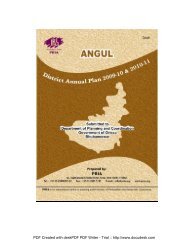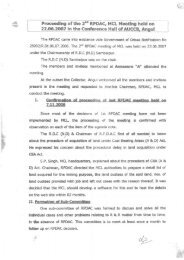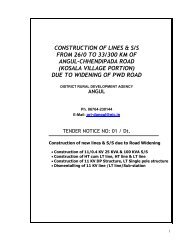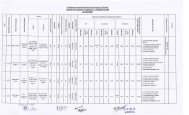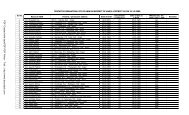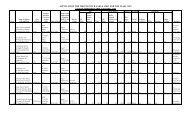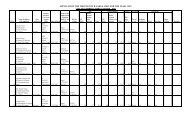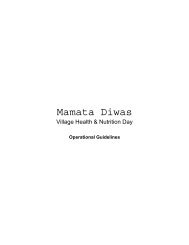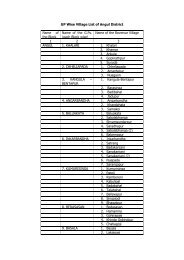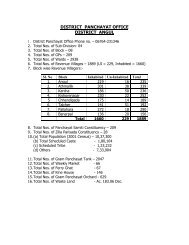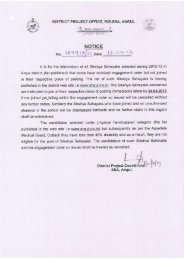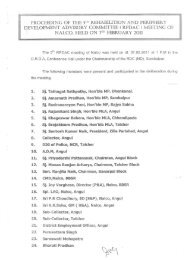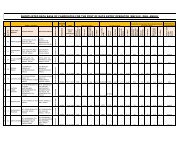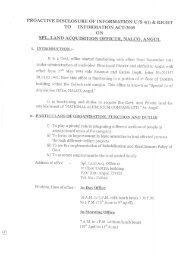PUSTIKAR DIWAS - Angul
PUSTIKAR DIWAS - Angul
PUSTIKAR DIWAS - Angul
Create successful ePaper yourself
Turn your PDF publications into a flip-book with our unique Google optimized e-Paper software.
<strong>PUSTIKAR</strong> <strong>DIWAS</strong><br />
A Child Survival Initiative<br />
Operational Guidelines
Sanatan Bisi<br />
Hon’ble Minister, Bhubaneswar<br />
Health and FW, Orissa Date: 12. 02. 2009<br />
Message<br />
It is my pleasure to learn that the Department of Health and Family<br />
Welfare, Government of Orissa, is observing “Pustikar Diwas” on the 15 th Day of<br />
every month at the Block PHC/CHC level for effective management, treatment<br />
and referral of severely malnourished children under five years of age, in<br />
collaboration with Women and Child Development Department. Under this child<br />
survival initiative, comprehensive management of Acute Malnutrition and their<br />
efficient referral to higher facilities is being carried out.<br />
In order to strengthen this initiative, a revised guideline has been<br />
developed under which provision for drugs, diagnostics and transport cost has<br />
been made which will be funded under National Rural Health Mission. Provision<br />
for giving Mobility Support to Anganwadi Workers / ASHAs has also been made<br />
for accompanying the malnourished children to Block PHC / CHC.<br />
Health and Family Welfare Department, Government of Orissa attaches<br />
very high importance to child survival Programmes. The State has also made<br />
substantial progress in reduction of IMR and coverage under immunization in the<br />
recent years. The strengthening of “Pustikar Diwas” initiative will further intensify<br />
the efforts of the Government and the people in the rural areas will be immensely<br />
benefited from this, in the time to come.<br />
I convey my best wishes to the Programme Officers and field level<br />
functionaries of the Health & Family Welfare Department, and Women & Child<br />
Development Department for success of this endeavor.<br />
(Sanatan Bisi)<br />
1
1. Introduction<br />
2. Objectives<br />
3. Implementation Guidelines<br />
4. Pre-activity<br />
5. Management Modalities<br />
6. Admission Criteria<br />
7. Admission Procedures<br />
8. Operational Modalities<br />
9. Discharge Criteria<br />
10. Roles and Responsibilities<br />
11. Other responsibilities<br />
12. Training & Orientation<br />
13. Follow up<br />
14. Reporting System<br />
15. Monitoring and Evaluation<br />
16. Financial Guidelines<br />
Annexures<br />
TABLE OF CONTENTS<br />
2
1. Introduction<br />
Severe malnutrition may act as a direct cause of death or an indirect cause by<br />
increasing dramatically the case fatality in children suffering from common childhood<br />
illnesses, such as, diarrhoea and pneumonia. Current estimates suggest that severely<br />
malnourished children have a 10 to 20 times higher risk of dying than well nourished<br />
children.<br />
In the past, formal treatment of severe malnutrition was restricted to inpatient<br />
approaches which greatly limited coverage and impact. Exciting new evidences suggest<br />
that large numbers of severely malnourished children can be treated in the community<br />
and do not need to be admitted into a hospital. There is an urgent need to incorporate<br />
the community-based approach as an integral part of the management of children with<br />
malnutrition to reach out to the majority of children and address this important cause of<br />
childhood mortality.<br />
To effectively combat the problems of malnutrition and to reduce malnutrition<br />
prevalence rate in Orissa (from 44% to 35% by 2012: NRHM Goal) “Pustikar Diwas” has<br />
been conceptualized. This activity is one of the strategic interventions by the joint efforts<br />
of Health & Family Welfare Department and Women & Child Development department.<br />
This is to be organized once on the 15 th Day of every month, in the Block PHC/CHC.<br />
Children in the Grade II, III, IV or severely underweight (New WHO Growth Standards) or<br />
severely acutely malnourished (MUAC
• To strengthen the capacity of individuals, families, communities and the<br />
health systems to effectively manage and prevent malnutrition.<br />
3. Implementation guidelines<br />
Organization of the Day<br />
• Information about the Pustikar Diwas will be prominently displayed in the<br />
AWC / SC/ PHC/ CHC / in the form of fixation of Board.<br />
• Prior information to community to be given by ASHA, AWW with the help of<br />
PRI representatives & NGOs.<br />
• AWW must be present on the day. BEE / LHV / ICDS Supervisor / MO<br />
/AYUSH MO/ CDPO/BPO as per the plan will participate and supervise the<br />
activities.<br />
• All required logistic must be made available at the site. Those are: IEC<br />
Materials, weighing machines, History taking formats, registers for enrollment<br />
and money disbursement, referral slips.<br />
4. Pre-Activity<br />
• AWW will identify the malnourished children after measuring MUAC &<br />
weighing all the children in the VHND/AWC.<br />
• AWW will fill-up the referral slip prior to 15th & handover to the parents. In<br />
case the AWW is not able to accompany the identified undernourished<br />
children to the Pustikar Diwas site, she will inform the ASHA to complete the<br />
task. She will give detail information of the child to the ASHA.<br />
• The ASHA will meet the parents & take the full information of the child. She<br />
will also finalize the time & mode of journey from village to PHC/CHC.<br />
• On 15 th ASHA will accompany the child (in the event of AWW not able to<br />
accompany) with the referral slip and MAA O SISHU SURAKHYA card will be<br />
attached with the referral slip (this will be utilized as a monitoring tool).<br />
• The AWW will maintain the referral register & follow-up register.<br />
• The ASHA/AWW shall explain the entitlements to be received to the parents<br />
of the child.<br />
• Availability of one Medical Officer in the PHC/CHC on the “Pustikar Diwas” is<br />
a mandatory requirement for effective check up and management of<br />
malnourished children.<br />
• In case the child admitted in the hospital, necessary funds can be availed<br />
form block RKS funds towards medicines & other expenses<br />
4
5. Management Modalities<br />
The treatment of malnourished children will be based on 2 phases<br />
Phase1: Patients without an adequate appetite and/or a major medical complication are<br />
admitted to an in-patient facility (District/Sub-district Hospital) for Phase 1 treatment.<br />
Patients that are admitted are to be treated on a 24/24 hour basis, receiving the diet and<br />
full medical treatment of complications. For all in-patients, as soon as they regain their<br />
appetite and medical complications treated should be shifted to Phase 2 and should<br />
continue treatment as out-patients in Phase 2.<br />
Phase2: Whenever patients have good appetite and no major medical complication they<br />
enter Phase 2, the patients are managed at home. Out-patient care, in the community,<br />
should also be organized from PHC/CHC. The patients attend on a monthly basis.<br />
Majority of patients can be managed entirely on an out-patient basis.<br />
There needs to be a functioning communication and referral system between the<br />
PHC/CHC and DHH/SDH so that patients can be quickly and easily transferred from the<br />
in-patient facility to the out-patient programme as they enter Phase 2 and those outpatients<br />
that fail to respond appropriately or who develop a complication can be admitted<br />
(temporarily) as in-patients.<br />
6. Admission Criteria<br />
PHC/CHC Out-patient Phase 2<br />
• Any child 0-5 years of age in Grade II, III or IV malnutrition or Severe<br />
Underweight as per the new WHO Growth Standards.<br />
• Any child 6 months - 5 years with MUAC of < 115 mm and/or presence of<br />
bilateral pitting edema<br />
These are malnourished children who are alert, have a good appetite, are clinically well,<br />
and are not having generalized edema.<br />
DHH/SDH In-patient Phase 1<br />
• Any child 0-5 years of age with medical complications or severe loss of appetite.<br />
A poor appetite means that the child has a significant infection or a major metabolic<br />
abnormality such as liver dysfunction, electrolyte imbalance, cell membrane damage or<br />
damaged biochemical pathways. These are the patients at immediate risk of death.<br />
Furthermore, a child with a poor appetite will not take the diet at home and will continue<br />
to deteriorate or die.<br />
5
These complications include the following:<br />
• Generalized bilateral pitting edema Grade 3 (+++)<br />
• Severe vomiting/ intractable vomiting<br />
• Hypothermia: axillary’s temperature < 35°C or rectal < 35.5°C<br />
• Fever > 39°C<br />
• Number of breaths per minute:<br />
o 60 resps/ min for under 2 months<br />
o 50 resps/ minute from 2 to 12 months<br />
o >40 resps/minute from 1 to 5 years<br />
o 30 resps/minute for over 5 year-olds<br />
or<br />
• Any chest in-drawing<br />
• Extensive skin lesions/ infection<br />
• Very weak, lethargic, unconscious<br />
• Fitting/convulsions<br />
• Severe dehydration based on history & clinical signs<br />
• Any condition that requires an infusion or NG tube feeding.<br />
• Very pale (severe anaemia)<br />
• Jaundice<br />
• Bleeding tendencies<br />
• Other general signs the clinician thinks warrants transfer to the in-patent facility<br />
for assessment<br />
7. Admission Procedure<br />
Screen the patients in the community (weight for age – plot on growth chart in the<br />
MOSS Card, MUAC and check for edema) during the Mamta Divas and refer the<br />
patients to the PHC/CHC on the Pustikar Divas if they fulfill the criteria. Every<br />
opportunity other than “Mamata Diwas” should be taken to identify patients.<br />
At the PHC/CHC, retake the anthropometric measurements (confirm the<br />
nutritional grade/MUAC at PHC/CHC) and check edema, errors during screening occur.<br />
There has to be feed-back to the community worker and possible retraining.<br />
On arrival at the Pustikar Divas, obviously ill children and those that will clearly<br />
need in-patient or other medical treatment should immediately be given sugar water and<br />
6
“fast tracked” without having to wait for the rest of the patients to be seen. They have<br />
their anthropometry checked and are then referred directly to the DHH/SDH for in-patient<br />
management. Sugar water is approximately 10% sugar solution – 10g of sugar per<br />
100ml of water. If the in-patient facility (DHH/SDH) is a long way away the transport can<br />
lead to serious deterioration of the patient. Admit the patient to PHC/CHC, keep the<br />
patient quiet and start treatment pending the availability of transport.<br />
For those that do not require “fast tracking” and fulfill the criteria should be<br />
examined and counseled on appropriate feeding and care practices. Families are<br />
advised to give frequent nutrient-dense foods, using locally available, culturally<br />
acceptable low-cost family foods, along with appropriate minerals and vitamins. Recipes<br />
of preparing energy and protein dense foods need to be shared with families. Treatment<br />
of young children should include support for breastfeeding and messages on appropriate<br />
feeding practices for infants and young children. Children under 6 months of age should<br />
not receive solid family foods. These children need milk-based diets, and their mothers<br />
need support to reestablish breastfeeding.<br />
Treatment at home enables caregivers to continue with economic activities and<br />
family responsibilities including caring for other children. It also reduces the exposure of<br />
the patient to cross infections, common in health institutions and feeding centres.<br />
Success of out-patient management can be ensured by<br />
• Advice being specific, clear, realistic and should not conflicts with cultural beliefs<br />
• Advice should be memorable and provide an opportunity to learn through<br />
supervised practice (Mamta Divas)<br />
• Frequent meals<br />
• Meals should be sufficiently energy and protein dense<br />
• Timely management of infections and poor appetite, do not withhold food during<br />
illness<br />
Fathers/other influential members should be involved: they often control families’<br />
finances.<br />
7
8. Operational Modalities<br />
SAM Children with Medical<br />
Complication<br />
Initiate initial treatment at<br />
PHC/CHC<br />
Refer to SDH/DHH for<br />
management<br />
• The total cost of the management of the child will be paid on the spot. The<br />
BPO/BADA will keep advance amount for necessary payment and will be<br />
responsible for making the cash payment to the beneficiary<br />
9. Discharge Criteria<br />
Discharge form Phase 1 (DDH/SDH)<br />
Arrival at PHC/CHC<br />
Registration<br />
Detail case history;<br />
Physical examination &<br />
Assessment<br />
• Child has recovered fully from medical complication<br />
• Return of good appetite, child well and alert<br />
• Major loss or disappearance of edema<br />
SAM Children without<br />
Medical Complication<br />
Refer for counseling & relevant<br />
advice on home based<br />
management & follow up<br />
Exit<br />
8
Discharge form Phase 2 (PHC/CHC)<br />
• MUAC > 115 mm for children 6months-5 years of age<br />
• Absence of bi-lateral edema for more than 10 days<br />
• Clinically well and alert<br />
10. Roles and Responsibilities<br />
ADMO (FW) will be the Nodal Officer of ‘Pustikar Diwas’ at District level and MO<br />
i/c of the Block PHC will be responsible for ‘Pustikar Diwas’ at Block level<br />
To facilitate the Pustikar Divas more effective for the management of severe<br />
malnourished children the roles & responsibilities of both ICDS & Health are clearly<br />
defined<br />
ICDS<br />
Health<br />
Roles of AWW (at AWC level)<br />
• Anthropometric measurements<br />
(weighing, MUAC)<br />
• Malnutrition grading (plotting of<br />
growth chart)<br />
Role of Supervisor<br />
• Counseling and advice on relevant<br />
issues through growth monitoring<br />
card and other IEC materials<br />
11. Other responsibilities<br />
CDMO & DSWO<br />
Roles of MO / AYUSH MO / LHV / SN /<br />
ANM<br />
• Registration<br />
• History taking in detail (refer to<br />
History taking format)<br />
• Anthropometry (MUAC & Weight)<br />
• Physical examination<br />
• Screening of cases with and without<br />
acute symptoms of severe<br />
malnutrition<br />
• Refer SAM children without medical<br />
complications for counseling to<br />
ICDS supervisors after providing<br />
follow up advice<br />
• Initiate initial management of SAM<br />
children with medical complications<br />
• Refer SAM children with medical<br />
complications to higher centre<br />
(SDH/DHH)<br />
CDMO & DSWO will responsible to orient the MOs & the CDPOs on the<br />
guideline<br />
9
CDMO to ensure that all PHC to have observe and monitor pustikar divas.<br />
The CDMO, ADMO (FW), DPM & DSWO will supervise every month in the<br />
district<br />
DPM & BPO will coordinate the activities and report every month from district<br />
to the State<br />
BPO will maintain the registers of enrollment & money disbursement<br />
12. Training and Orientation<br />
There is provision of combined training of functionaries on VHND and Pustikar<br />
Diwas, as described under VHND Training Strategy. There will be one day training for<br />
State, District and mid-level managers; and half-day training for ANM, AWW and ASHAs.<br />
The main focus would be to orient them on management of malnutrition, clinical<br />
protocols & follow-up activities.<br />
13. Follow-up<br />
• On 16 th ASHA, mother/ parents & AWW will meet & they will discuss about the<br />
instruction given by the MO. If the child is admitted in the DDH/SDH, ASHA will<br />
inform to the AWW.<br />
• The follow-up activities at the household level would be done by ASHA &<br />
supervised by the AWW; Surprise visit will be done by the respective Supervisor.<br />
• AWW/ ASHA will visit the home of the child, guide and counsel the mother on<br />
feeding, personal hygiene & child care practices.<br />
• There should be at least three home visits in the first week and there after from<br />
second week onwards, one visit at every 7 days interval. The two-fold objectives of<br />
such visits is a) to assist the mothers in practicing new skills of infant and young<br />
child feeding preparation; and b) and to ensure treatment compliance as advised.<br />
• During Mamta Divas the ASHA & AWW will meet the Village Health & Nutrition<br />
committee, SHGs & other family members in a meeting within the community &<br />
discuss about malnutrition & referral.<br />
• For supervision activity the CDPO will visit the houses at random and review the<br />
referrals at sector/ project level respectively.<br />
14. Reporting System<br />
Reporting will be undertaken every month from Block level on the day of 1 st<br />
sector meeting in the prescribed format. These reports will be compiled by the BPO at<br />
10
Block level. The Block MO will submit the report of PHC and supervisory report to the<br />
district by 7 th of every month. The CDMO after consolidating the PHC reports will submit<br />
the same to State Maternal & Child Survival Cell under Directorate of Family Welfare<br />
with a copy to Mission Director, NRHM, by 10 th day every month. Various formats have<br />
been developed and attached in the Guideline for ready reference, as:<br />
1. History Taking Format<br />
2. Monthly Block Reporting Format<br />
3. Monthly District Reporting Format<br />
4. Enrollment Register<br />
5. Financial Support Register<br />
6. Referral Slips<br />
15. Monitoring and Evaluation<br />
The quality of services offered & available during Pustikar Diwas will depend on<br />
the quality of the supervision and leadership. The MOs and the District level Supervisors<br />
should jointly visit the centers submit their reports on a regular basis, which will be<br />
discussed at the monthly meeting convened by the CDMO. During the supervisory<br />
visits, special attention should be given to the following elements:<br />
• How many children from vulnerable communities availed the services?<br />
• Whether or not the Doctor was available at the Centre?<br />
• Whether or not all resources (human resources and materials) in place?<br />
• Whether there is any compromise on the quality of the services?<br />
Moreover, issues related to the client satisfaction should be addressed as and when felt<br />
appropriate.<br />
Below given are the Performance and output indicators for the management of<br />
malnutrition in Phase 1 and Phase 2, per time period:<br />
• Number and percentage of PHC/CHC conducting Pustikar Diwas<br />
• Number of registered patients (new admissions)<br />
• Number of discharge<br />
• Number and percentage cured<br />
• Number and percentage died<br />
11
• Number of referrals to inpatient care<br />
• Number admitted from PHC/CHC<br />
• Number of staff (e.g. health care providers, community health workers [ANMs.<br />
AWWs], volunteers) trained<br />
16. Financial Guidelines<br />
There are threefold provisions under the Programme: a) Essential medicine cost<br />
of Rs 200 per child (subject to actuals, to be reimbursed); b) Investigation cost of Rs 50<br />
per child (subject to actuals, to be reimbursed); and c) Second Referral Transportation<br />
cost of Rs 200 to be paid in cash to the parents of the beneficiary from the second<br />
referral point (SDH/FRU/DHH). This must be mentioned in the Second Referral Slip<br />
and countersigned by the MO or any person in charge of authorizing the payment. While<br />
the first two provisions (a) and (b) are only for those cases who come on the Pustikar<br />
Diwas Day to the First Referral Point carrying the First Referral Slip, the third provision<br />
(c) is for all those cases that come carrying the Second Referral Slip on any day and at<br />
any time to the Second Referral Point.<br />
Financial summary is thus as follows:<br />
• Investigation Cost: 50/- under “Pustikar Diwas” a/c (to be reimbursed)<br />
• Essential Medicines cost: 200/- under “Pustikar Diwas” a/c (to be reimbursed)<br />
• 2 nd Referral Cost: 200/- (any day, any time) under “Pustikar Diwas” a/c<br />
Annexure<br />
i. WHO Growth Standards<br />
ii. Referral slips<br />
iii. Register for enrollment<br />
iv. History taking format<br />
v. Register for financial support<br />
vi. Monthly Block Reporting format<br />
vii. Monthly District Reporting format<br />
12
Annexure l: WHO Growth Standards<br />
What are the WHO Child Growth Standards?<br />
The World Health Organization has launched new global Child Growth Standards<br />
for infants and children up to the age of five. These have been accepted by the Govt. of<br />
India, plans are being drawn up on training of the community workers on the use of<br />
these growth charts. Until now the 1977 National Center for Health Statistics (NCHS)<br />
were used.<br />
The new WHO Child Growth Standards confirm that children born anywhere in<br />
the world and given the optimum start in life have the potential to develop to within the<br />
same range of height and weight. The new standards prove that differences in children's<br />
growth to age five are more influenced by nutrition, feeding practices, environment, and<br />
healthcare than genetics or ethnicity.<br />
WHO and its principal partner, the United Nations University, undertook the Multicentre<br />
Growth Reference Study (MGRS) which was a community-based, multi-country<br />
project involving more than eight thousand children from Brazil, Ghana, India, Norway,<br />
Oman, and the United States of America.<br />
The new growth charts include growth indicators such as weight-for-age,<br />
length/height-for-age, and weight-for-length/height. For the first time, there now exists a<br />
Body Mass Index (BMI) standard for children up to age five, as well as the Windows of<br />
Achievement standard for six key motor development milestones.<br />
With these new WHO Child Growth Standards it is now possible to show how children<br />
should grow.<br />
Current growth reference<br />
Until recently National Centre for Health Statistics (NCHS) standards were used for<br />
assessment of nutritional status of preschool children. These NCHS standards have the<br />
following limitations:<br />
• The standards were based on formula fed children from a single community in<br />
the USA; growth pattern of breast fed infants is different from that of formula fed<br />
infants<br />
• Children were measured once every three months, which is not adequate to<br />
describe the rapid and changing rate of growth in early infancy.<br />
• There were shortcomings inherent in the statistical methods available at that time<br />
which led to inappropriate modeling of growth patterns.<br />
13
Differences between the new WHO standards and NCHS references<br />
The growth charts based on the new WHO standards differ from the existing<br />
standards in many innovative ways. They describe ‘how children should grow’, which is a<br />
prescriptive approach, not just a descriptive one.<br />
The pooled sample from the six participating countries creates a truly<br />
international standard, in contrast to the previous growth reference based on children<br />
from a single country.<br />
A key characteristic of the new standard is that it makes breastfeeding the<br />
biological “norm” and establishes the breastfed infant as the normative growth model.<br />
The previous reference was based on the growth of artificially-fed children.<br />
There are charts for boys and for girls, and for infants to one year, and for<br />
children up to five years.<br />
In the growth charts used in our country, underweight children were classified as<br />
Grade I, II, III and IV, the new growth chart will classify underweight children as<br />
Moderately Underweight and Severely Underweight.<br />
Additionally, the new Child Growth Standards also include Windows of<br />
Achievement describing the range and timeline for six key motor development<br />
milestones for children, such as sitting without support, crawling, standing with<br />
assistance, walking with assistance, standing alone and walking alone. This provides a<br />
unique link between physical growth and motor development.<br />
As expected, there are important differences between the new WHO standards<br />
and NCHS references. However, these vary by age, sex, anthropometric measure.<br />
Differences are particularly important in infancy.<br />
Computed under-nutrition rates in the critical 0-6 month age group with new<br />
WHO standard are higher as compared to under -nutrition rates derived from NCHS<br />
standards. This should be viewed as a correction of a historical fallacy and not as<br />
alarming rise in under weight rates in 0-6 age group.<br />
In the 1-5 year age group the computed undernutrition rates using the new WHO<br />
standards are substantially lower as compared to those computed from NCHS<br />
standards. This should not be allowed to generate a sense of complacency that<br />
undernutrition rates are falling<br />
A notable effect is that stunting will be greater throughout childhood when<br />
assessed using the new WHO standards compared to the previous international<br />
reference.<br />
For wasting, the main difference between the new standards and the old<br />
reference is during infancy, up to about 70 cm length, when wasting rates will be<br />
substantially higher using the new WHO standards.<br />
14
Financial Guidelines for<br />
Grade ll / Grade lll and Grade lV under-nourished children<br />
AWC<br />
(VHND Site)<br />
• Incentives: Total<br />
200/- per session at<br />
AWC under “VHND”<br />
a/c<br />
• 1 st Referral<br />
Transport Cost: 150<br />
to 200/- (any day, any<br />
time) under “VHND”<br />
a/c<br />
• Accompanying Cost:<br />
100/- per session for<br />
AWW / ASHA under<br />
“VHND” a/c<br />
Block PHC<br />
(1 st Referral Point<br />
or ‘Pustikar Diwas’<br />
Site)<br />
1 st Referral 2 nd Referral<br />
• Investigation<br />
Cost: 50/- under<br />
“Pustikar Diwas”<br />
a/c (to be<br />
reimbursed)<br />
• Drugs cost: 200/-<br />
under “Pustikar<br />
Diwas” a/c (to be<br />
reimbursed)<br />
FRU / DHH<br />
(2 nd Referral Point)<br />
• 2 nd Referral<br />
Transport<br />
Cost: 200/-<br />
(any day,<br />
any time)<br />
under<br />
“Pustikar<br />
Diwas” a/c
Reg No: 2 nd Referral Slip Reg No: 2 nd Referral Slip Reg No: 2 nd Referral Slip<br />
Slip for First Referral Point: This portion<br />
to be retained at the First Referral Point<br />
Name of the AWC/<br />
SC………………………………….<br />
Slip for Second Referral Point: This<br />
portion to be retained at the 2 nd Referral Point<br />
Name of the AWC/<br />
SC………………………………….<br />
Doctor's Prescription: This portion to be<br />
given to the parents of the child. They should<br />
retain this carefully for future use<br />
Name of the AWC/<br />
SC………………………………….<br />
Sl. No. …………. Date: ………………….. Sl. No. …………. Date: ………………….. Sl. No. …………. Date: …………………..<br />
Name of Child: …………………………… Name of Child: …………………………… Name of Child:……………………………<br />
Age: …………………………………. Age: ………………………………………….. Age:………………………………….<br />
Sex:M/F:…………………………………. Sex:M/F: …………………………………….. Sex:M/F: ………………………………….<br />
Birth Order:…………………………………. Birth Order: …………………………………. Birth Order: ……………………………….<br />
Grading: II/III/IV: …………………<br />
Grading: II/III/IV: ………………………<br />
Grading: II/III/IV: ………………………<br />
MUAC:--------------------------------<br />
MUAC:--------------------------------<br />
MUAC:--------------------------------<br />
Complaint: …………………………………. Complaint:…………………………………. Complaint:………………………………….<br />
Referred to<br />
(SDH/DHH):………………………………….<br />
Signature of the Referrer (MO/Others)<br />
Referred to<br />
(SDH/DHH):………………………………….<br />
Signature of the referred person<br />
Did the patient receive Rs 200/- as Transport<br />
Cost?<br />
Signature of the I/C Desk (BPO/ CDPO/ MO<br />
I/C/ Others)<br />
Referred to Medical College (if any):<br />
Diagnosis: ……………………………….<br />
Prescription:<br />
Did the patient receive Rs 200/- as Transport<br />
Cost?<br />
Doctor’s Signature<br />
Name (Capital): …………………………..<br />
• * Orange color Slip: This Referral Slip will be filled up by the AWW and in her absence, by the Staff Nurse. Payment to the patient will be made by the<br />
office of the 2nd Referral Point (SDH/DHH). BPO will be responsible for the payments to the Patients under the guidance of the MO i/c of the hospital.
History Taking Format (Pustikar Divas)<br />
Basic information<br />
Name of the District<br />
Registration No<br />
Name of the Patient Age Sex<br />
Father's Name<br />
Address<br />
Name of Sub Centre<br />
Name of Block<br />
Weight<br />
MUAC<br />
Bipedal Oedema / Visible Wasting<br />
Grade of Malnutrition ( ll / lll / lV)<br />
Development milestones: Sit / Crawl / Stand / Walk)<br />
Medical History<br />
Complaints (in order of appearance)<br />
l)<br />
ll)<br />
lll)<br />
lV)<br />
V)<br />
Current Illnesses (describe):<br />
Appetite (hungry / normal / poor / no appetite)<br />
Vomiting (Yes / No)<br />
Diarrhoea (Yes / No)<br />
Mental Condition: Alert / Lethargic / Unconscious<br />
Apprearance of stool (bloody / watery / other specify)<br />
Worm infestations (Yes / No)<br />
Oedema (None / feet / face / abdomen / general)<br />
Dehydration: Nil / Mild / Moderate / Severe<br />
Respiratory distress (Yes / No)<br />
Cough (Yes / No)<br />
Fever (Yes / No) Weight loss (Yes / No)<br />
Dietary History<br />
Age at which breastfeeding stopped<br />
Usual diet before current illness<br />
Diet since current illness began<br />
Diet during past 24 hours<br />
Final Diagnosis and Treatment<br />
N.B This form will be filled up by the ANM / SN
Name of Block<br />
Name of District<br />
Sl No Date Regn No Patients' Name Age (m/y) Sex Father's Name Address<br />
*N.B: Grade malnutrition<br />
Old System New System<br />
A: Grade l D: MUAC of less than 115 mm if the height is less than 65 cm<br />
B: Grade ll E: MUAC of less than 110 mm if the height is more than 65 cm<br />
C: Grade lll F: Visible bipedal oedema<br />
G: Visible Wasting<br />
N.B: This register will be filled up by Staff Nurse / LHV<br />
Enrollment Register (Pustikar Diwas)<br />
BPL /<br />
APL<br />
Caste: SC<br />
/ ST /OBC<br />
/ Gen<br />
Distance<br />
between AWC<br />
and 1st<br />
Referral Point *Status of Treatment<br />
(Km) Malnutrition given<br />
Discharged /<br />
Referred to<br />
2nd Referral<br />
Point with<br />
Date
Name of Block<br />
Name of District<br />
Sl No Date Regn No Patients' Name Age Sex Father's Name Address<br />
N.B: This register will be filled up by BADA<br />
Financial Support Register (Pustikar Diwas)<br />
Distance<br />
between<br />
home and<br />
referral point<br />
(Km)<br />
Malnutrition Financial Support<br />
With Without<br />
medical medical For<br />
complicati complicati Mobility<br />
on on (Rs)<br />
For Drugs<br />
(Rs)<br />
Investigatio Signature of<br />
n Cost (Rs) beneficiary
For the month of:<br />
Name of the District:<br />
Name of the Block:<br />
No of AWCs in the Block:<br />
Total No of malnourished children<br />
examined (A)<br />
Out of (A), Grade ll<br />
Out of (A), Grade lll<br />
Out of (A), Grade lV<br />
MUAC less than 110 mm (11.00 cm),<br />
when ht is less than 65 cm<br />
MUAC less than 115 mm (11.5 cm),<br />
when ht is more than 65 cm<br />
Visible bipedal Oedema<br />
Visible Wasting<br />
Total No of children with medical<br />
complications (B)<br />
Out of (B), Grade ll<br />
Out of (B), Grade lll<br />
Out of (B), Grade lV<br />
MUAC less than 110 mm (11.00 cm),<br />
when ht is less than 65 cm<br />
MUAC less than 115 mm (11.5 cm),<br />
when ht is more than 65 cm<br />
Visible bipedal Oedema<br />
Visible Wasting<br />
No of New cases, this month:<br />
No of follow-up cases, this month:<br />
No of children managed / treated at the centre, this month:<br />
No of children referred to higher facilities, this month:<br />
Remarks, if any<br />
N.B: This form will be filled up by the BPO<br />
Monthly Block Reporting Format: Pustikar Diwas<br />
0-3 yrs 3-6 yrs Total<br />
Male Female Male Female Male Female<br />
0-3 yrs 3-6 yrs Total<br />
Male Female Male Female Male Female<br />
Signature of MO / BPO
For the month of:<br />
Name of the District:<br />
No of AWCs in the Block:<br />
Total No of malnourished<br />
children examined (A)<br />
Out of (A), Grade ll<br />
Out of (A), Grade lll<br />
Out of (A), Grade lV<br />
MUAC less than 110 mm (11.00<br />
cm), when ht is less than 65 cm<br />
MUAC less than 115 mm (11.5<br />
cm), when ht is more than 65 cm<br />
Visible bipedal Oedema<br />
Visible Wasting<br />
Total No of children with medical<br />
complications (B)<br />
Out of (B), Grade ll<br />
Out of (B), Grade lll<br />
Out of (B), Grade lV<br />
MUAC less than 110 mm (11.00<br />
cm), when ht is less than 65 cm<br />
MUAC less than 115 mm (11.5<br />
cm), when ht is more than 65 cm<br />
Visible bipedal Oedema<br />
Visible Wasting<br />
No of New cases, this month:<br />
No of follow-up cases, this month:<br />
No of children managed / treated at the centre, this month:<br />
No of children referred to higher facilities, this month:<br />
Remarks, if any<br />
Monthly District Reporting Format: Pustikar Diwas<br />
0-3 yrs 3-6 yrs Total<br />
Male Female Male Female Male Female<br />
0-3 yrs 3-6 yrs<br />
Total<br />
Male Female Male Female Male Female<br />
N.B.: This form will be filled up by the Child Health Coordinator / ADMO (FW)<br />
Signature of CDMO / ADMO (FW)



